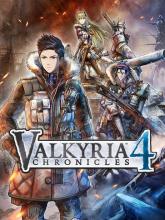Rating of
5/5
An Excellent Tactical RPG
Matt - wrote on 11/26/21
Valkryia Chronicles IV (VC4) is a delightfully complex tactical RPG developed by Sega (with the help of Media Vision). It was first released on the Playstation 4 in Japan, but later came to all the consoles—Xbox One and Nintendo Switch—and the PC in September of 2018. The game is the fourth installment in the Valkryia Chronicles (VC) series, and the second re-leased for consoles/PC. Valkyria Chronicles II and III were developed as Playstation Portable exclusives. Sega has nearly perfected the series in this fourth release with a rich and sophisticated story, excellent gameplay that iterates upon the first game, and a beautiful visual presentation, which brings continuity to the series.
Story (5 out of 5)
The setting of the game is the Second Europan war, inspired by the events of World War II. It takes place after the First War (the subject of Valkyria Chronicles I). The protagonist is Claude Wallace, a tank commander of Squad E, who plays an integral role in the Federation’s advance to topple the Empire. Wallace is accompanied on this task by his child-hood friends, Raz, Kai, and Riley. The context of their friendships, told as the game progresses, adds to the richness of the story, and each character’s personality and history help draw the audience into the action.
The game’s plot covers two phases of the conflict between Federation and Imperial forces. The first part involves Squad E’s role in Operation Northern Cross as the Federation advances to the imperial stronghold, the Siegval Line. The second phase of the game takes place on the Crystal Sea, as Squad E races towards Schwartzgrad, the Imperial capital, using the latest Federation technology, giant snow cruisers.
The story does well to deal with the brutalities of war, as the characters encounter Imperial troops who are fighting to defend their own families, livelihoods, and loved ones. This theme is also explored in side-quests which tell the backstory of various characters who join Squad E. The strength of the story, on the whole, is in the ethical dilemmas that it navigates, especially in a world that is not black or white but mixed with grey. Essentially, it’s like the real world, in some sense. Situations that we as humans face are complex, and the intentions of moral agents are usually a blend of good and bad. VC4 does well in dealing with such reality. It creates sympathy in the audience for those caught in power struggles between governments —on all sides. For example, Colonel Klaus Walz, Wallace’s primary rival, demonstrates great compassion and sacrifice for those abused by the powerful, de-spite his over-the-top machismo. Even one of the primary antagonists, Foresti, reveals a complex motivation to protect the vulnerable, though he becomes twisted in the means on how to accomplish it. I found these ethical complexities interesting, philosophical, and valuable to the game. Machiavelli’s contemplation whether the ends justify the means is woven throughout the story.
The theme of technological progress is also fascinating as Lord Belgar, the other primary antagonist, seeks it as an end, and thus becomes twisted by pursuit of experimentation without ethical boundaries. The complicated story lines involve victims of power struggles dealing with the implications of such pursuits, and all sides are morally compromised. The Federation has its own issues, very similar to the Allies in World War II as they decide to drop the atomic bomb. Loss, friendship, corruption, growth, redemption, the abuses of scientific knowledge, all make the story worth telling.
My single complaint is more about the quality of the dialog, which at times tended to be pedestrian and take too much time to develop. Nevertheless, the rich and complex story, along with the gameplay, make this a must play for the eight generation of consoles.
Gameplay (5 out of 5)
The gameplay of VC4 is challenging (save often), but excellent. It builds on the first console game for the PS3 with tried-and-true elements of a tactical RPG. This solid implementation is centered around various character classes—Snipers, Scouts, Shocktroopers, Lancers, etc. Each type has strengths and weaknesses, and they level-up throughout the game, gaining improved stats. VC4 improves on the original game with the addition of the Grenadier class, a long-range ballistic type, slow to move, but very effective at clearing out enemies. I found grenadiers immensely enjoyable to use, and often focused my strategy on them, using at least two in deployment. The Grenadiers are able specialize in causing either infantry or armored damage, depending upon their weapon equipment (the VC series includes weapon upgrades and development, along with class leveling). Depending upon the encounter, my Grenadier who specialized in armor damage would help tackle a boss, whereas the other would help clear out ground troops.
I also enjoyed the unique terrain and mechanics of the game, which were solid iterations on the first installment. The terrain for the first part of the game is very similar to VC1 with minor adjustments for improvement. However, the second phase is set on the Crystal Sea, which brings a number of gameplay additions. Fog, avalanches, snow drifts, overhangs of ice, crevasses, add complexity to the gameplay. Some elements are time-bound, where a player has to act within a round (e.g. the fog will lift or the blizzard end, revealing the position of your and the enemies’ troops), whereas others introduce new obstacles to remove, avoid, or navigate (avalanches, snowdrifts, and crevasses). Some levels included novel mechanics where certain character classes played more prominent roles. For example, in one stage snipers must destroy parachuted bombs and troops, defending your ship. These new mechanics made levels unique and added variety.
As the game progressed, I also found myself using the “Command” gameplay mechanic more frequently, where the commander, Claude Wallace, issues an order that buffs units. The Command takes up Action Points (each round you are given so many points to use), however these buffs were vital when attempting to complete missions with the A-Rank (the top honor for a level). Buffing the defense and attack of my infantry helped the Scouts and Shocktroopers navigate enemy fire and take enemy bases more easily. VC4 also allows a player to assign the status of “Leader” to a non-primary character. This gives you more AP at the beginning of each round and allows you to use that character to direct another character. This character then follows the leader on the battlefield, not using AP but instead it takes up a Special Point (you have one per round to use). This game mechanic would allow me to advance greater distances in a round, which often had strategic implications, especially as I attempted to finish a level in as few rounds as I could. The Commands and SP made the gameplay more creative.
Some new game mechanics were, however, not as useful. For example, in the second phase of the game, on the Crystal Sea, players are allowed to use the large snow cruiser as a support unit. You can use AP to direct the ship with an order to reveal parts of the map with radar, attack a location with artillery, or heal injured ships with a crew of medics. I did not find much use for these and focused my AP on having Claude issue orders that directly buffed my troops.
Presentation (4.5 out of 5)
The art style of VC4 is a visual delight which evokes feelings of a visual novel. The animation and scenes look hand drawn, and the effect is pleasing. Color is used effectively in character and scene design. The world is not brown and grey, but full of blues and greens. The seasons, towns, and time of day provide a unique visual palette that add variety to the presentation of the game. Characters are placed in scenes with contrasting elements. Colonel Walz with his crimson tank and Crymaria’s purple add contrast to the somewhat bland imperial soldiers.
My only complaints about the presentation are about the simple animation during many scenes of dialog between characters and the somewhat repetitive music. Each chapter in the game has at least one level of combat surrounded by scenes of dialog. Headshots of the characters talking are primarily presented, and the animation is not complex. The most important scenes for the story are fully animated. The simple dialog doesn’t look bad per se; however it would have been nice to have more animation for variety. The music of the game is well composed, and I have no complaints about the style or its effectiveness in telling the story. It is, however, repetitive. The addition of more songs for more settings or story would have enhanced the game even more. I am sure that budget constraints led to decisions about animation and music, so I don’t fault Sega too much.
Overall (5 out of 5, not an average)
VC4 is worth every minute of play. The complex story, enhanced iterations of game-play, and creative presentation provide hours of enjoyment. The value is only increased if you pick up the game on sale, which is likely given the date of publication. Those new to the series should give it a play, and, in the process, they might add the first title to their back-log.
Recent Comments
Nelson Schneider - wrote on 11/28/21 at 12:54 AM CT
Valkyria Chronicles 4 Review comment
The problem with dialog in Japanese games is the fact that Weebs demand LITERAL translations, instead of idiomatic localizations, like we got in the glory days of Ted Woolsey. The stilted exchanges we see in modern Japanese games are the way they are because that's how Japanese people speak. We should be glad that the original Japanese character names were Nipponized Western names, otherwise we'd be stuck with (more) Europan characters with Japanese names.





